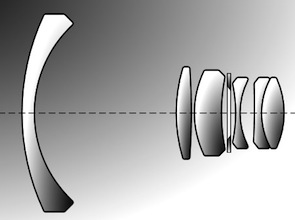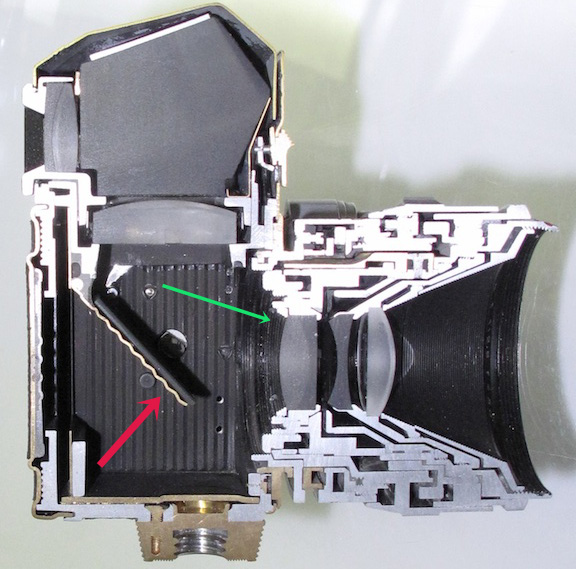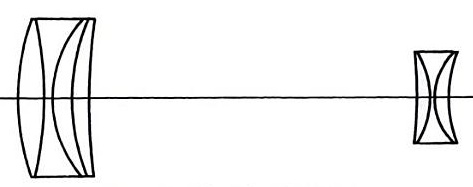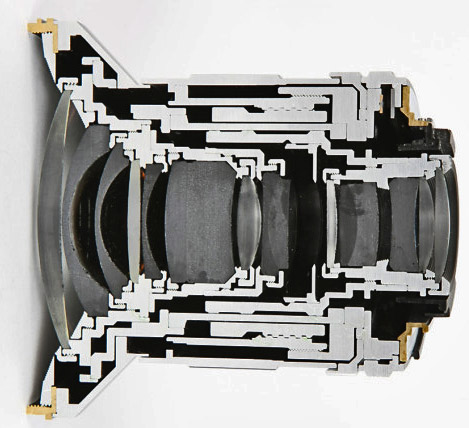History of Photography
Lens Genealogy – Part 2
For those who missed all the excitement, in Part 1 of this series I discussed that almost all modern SLR lenses derive from one of 6 types of lenses that were basically in use by the 1920s. Part 1 covered the first three lenses: the Symmetrical, Double Gauss, and Petzval lenses. Those three lenses give rise to almost every “standard range” prime lens (40 to 85mm) for SLRs and slightly longer and shorter lenses for medium format and rangefinder cameras. As we discussed in the first article, knowing the original type of lens lets us predict the type of aberrations it will be prone to.
Most of you, being skilled mathematicians, have already figured out that if the first three lenses only gave rise to the standard range primes, the other three (Telephoto, Reverse Telephoto, and Cooke Triplet) must have a lot more descendants. They do, so we’ve got a lot of ground to cover in this article.
The Lens Family Tree Part 2
The Telephoto Lens
First, the definition of telephoto is not “long focal length.” It’s “the lens is physically shorter than its focal length.” This is really quite handy, so that your 500mm lens doesn’t have to be 500mm (20 inches) long. Telephoto is also a specific type of lens design. All telephoto lenses have the same key structure: a powerful front positive element and a negative rear element that spreads the focused beam of light out, magnifying the image.
Advantages: Duh! The telephoto thing!
Disadvantages: Telephoto lenses naturally have pincushion distortion, and because of the telephoto group (which reduces the amount of light reaching the sensor) are not naturally wide aperture. This can be overcome, but requires making the lens very large with a wide front element — hence the reason we don’t handhold our 400mm f/2.8 unless we’re very young and very strong.
The most significant problem with the telephoto design, however, is longitudinal chromatic aberration. The negative rear element magnifies any aberrations — particularly longitudinal chromatic aberration (not color fringing, but rather blue light, red light, and yellow light focusing at slightly different focal lengths, making the image blurry). It is for this reason that all high-quality telephoto lenses have one or more low-dispersion elements.
History:
Telephoto lenses were developed simultaneously in the 1880s by prominent British and German lensmakers and also by a heavy drinking New Zealand geologist who (legend has it) ground his lens elements from the bottoms of his whiskey bottles. The first efforts were basically teleconverters added on to existing lenses. As you would expect, they were not of high quality. In the 1920s it was discovered that adding an additional element near the rear with a biconcave airspace (or glass equivalent) could reduce the pincushion distortion and low-dispersion elements would reduce the chromatic aberration. These improvements dramatically improved the quality of telephoto lenses.
Early on, lensmakers found splitting one strong element into two or more different elements provided several advantages. It was often less expensive to manufacture two weaker elements than one strong one and different glass types could be used for the two elements (reducing chromatic aberration). Most importantly, each glass surface can be bent or curved slightly differently to reduce one aberration or another. Splitting a single element into two separate elements gives the lensmaker four surfaces to bend rather than two.
Lensmakers were splitting and combining elements very early in the development of telephoto lenses, hoping to correct its inherent problems. One of the first telephoto lenses, the Zeiss Tele-Tubus of 1901, used multiple cemented elements to make up the positive front element and negative rear element of the lens, for example. Why cemented elements, rather than separate? Because lens coatings (which reduce light reflection) weren’t practical until the late 1930s, so every glass-air interface caused light reflection and reduced contrast. Cemented elements avoided that problem.
You have to look a bit carefully to see the basic ‘telephoto’ design in a modern telephoto lens: the simple positive and negative elements are always split into several separate elements, sometimes with a couple of additional elements to help control aberrations (and since we now have anti-reflective lens coatings, there’s no need to always cement them). There is usually an additional ‘collective’ group near the rear to eliminate pincushion distortion. However, the basic design remains: positive (convex) elements in the front, negative (concave) elements in the rear.

Lens diagrams of 3 telephoto lenses showing the positive front, negative rear construction and the liberal use of low dispersion glass (colored) in the positive elements.
Most SLR lenses of 135mm or greater are telephoto designs. The telephoto design is also used, surprisingly enough, when a very compact lens is needed (remember one definition of telephoto lens is ‘the lens is shorter than it’s focal length’). The tiny lenses used in the old Kodak disc cameras (equivalent to 44mm at f/2.8) were telephoto designs, keeping the lens very small. While the telephoto design does have several inherent problems, modern lensmakers have overcome them very consistently. Supertelephoto prime lenses today are among the sharpest lenses with the least aberration of any lenses made.
The Reverse Telephoto (retrofocus) Lens
The design of the reverse telephoto is, to no one’s surprise, exactly the opposite of the telephoto design: there is a strong negative element in front and a positive element in the rear.
Advantages: Allows focal length shorter than backfocus distance (the distance between the rearmost element and the sensor). This allows a lens of, say, 20mm focal length to have a rear element more than 20mm in front of the sensor (absolutely needed in an SLR, so the mirror has room to flip up without hitting the back of the lens). The design also provides a relatively high aperture with a wide field of view, has minimal vignetting and rarely has spherical aberration.
Disadvantages: Curvature of the field of focus is common. Aberrations change with near-far focus changes, so a lens that’s well corrected at infinity may not be at near focus, or vice-versa. Aberrations at wider angles are multiple and severe (coma and lateral chromatic aberration, as well as distortion), requiring numerous elements to correct them all. Distortion is particularly difficult to correct (some consider a fisheye lens simply an uncorrected reverse telephoto of very wide field of view).
A reverse telephoto is also usually a large lens. Have you noticed that 50mm lenses are usually the smallest, but lenses longer and shorter than 50mm both tend to be larger in size for an SLR? If you look at rangefinder lenses, that’s not always the case because they don’t require as much clearance.
History: The reverse telephoto was first designed in the 1920s for the movie industry: they needed lenses with long backfocus distances (distance from the back of the lens to the sensor) for Technicolor movie cameras, because the prism used in those cameras took up a significant space right behind the lens mount. Angenieux actually trademarked the term “retrofocus” so other makers for a time had to use the term “reverse telephoto” to describe their lenses. Today the terms retrofocus and reverse telephoto are used interchangeably to describe lenses of this type.

The design of the original Angenieux retrofocus lens showing the negative element in front, positive in the rear and several corrective elements between. Wikipedia commons.
When SLR cameras were first introduced in the 1930s, there were no wide-angle lenses available because an SLR camera requires the back of the lens to be far enough forward from the imaging plane that the mirror can flip-up during exposure. The Exactas (the first SLR) and other early SLRs had to use lenses of 40mm or longer until the retrofocus design was adapted for photography.

Cross section of a 1940s Exacta SLR demonstrating the back of the lens (green arrow) has to be far enough forward to allow the mirror (red arrow) to swing up when taking a picture.
Today any SLR lens wider than 40mm must be a retrofocus design. The negative front elements are almost always bent in a meniscus shape, and there are likely to be two or more of them. (The meniscus shape helps correct the field curvature and certain aberrations.) Similarly there are usually two or more positive elements at the rear of the lens, with several other elements in between. Almost every modern, high-quality reverse telephoto lens will have at least one aspheric element and wide-angle, wide-aperture lenses often have several to further reduce aberrations.
As you can see from the 3 examples below, retrofocus lenses tend to become more complex as the focal length becomes wider.
The multiple elements are required not just to form the image, but to correct the multiple aberrations the design naturally has – especially when you recall that the aberrations are going to be different at different focusing distances. A retrofocus lens, for example, may have prominent astigmatism when focused on nearby objects that disappears and is replaced by coma when focusing further away, etc. etc.
The number of elements and the design itself explains why a 24mm f/1.4 is usually more expensive and physically larger than a 50mm f/1.4. Look at the cutaway of a Zeiss 21mm f/2.8 lens below. Notice not just the number of glass elements but the multiple metal clips, stays, and shims required to hold them all in place. It’s pretty easy to see how one element might be slightly off center or tilted. Very wide-angle lenses are delicate things and a bit prone to side-to-side variation in sharpness for just that reason.
One interesting fact I encountered when researching lens design was that a small amount of distortion is often a trade-off for increased resolution. Therefore, the distortion found in two very sharp retrofocus lenses I shoot with (The Zeiss 21mm and Nikon 24mm f/1.4) may have been a conscious choice of the designer to maintain sharpness, not a design flaw.
The Cooke Triplet Lens
The most important lens, the one that gave rise to more lenses than any other, I saved for last. The triplet is possibly the most important design ever — not just because it gave rise to a huge number of other lenses in the first half of the 20th century, but because a simple trait of the triplet lens is found in the vast majority of lenses we shoot with today.
Advantages: Simple and inexpensive to produce. Gives reasonably good correction of all aberrations.
Disadvantages: Without modification is not effective at apertures greater than f/2.8 or at a field of view greater than 60 degrees (equivalent to 35mm on a full-frame SLR). The strong elements require very exact adjustments and tight manufacturing tolerances. (In fact, the original triplets were manufactured with the center element set in adjusting screws which were fine tuned on a test bench and then cemented in place before it was sold.)
History: Dennis Taylor designed the triplet lens in the 1890s and it was produced by the Taylor Hobson Company and many other manufacturers. (If you want to know why it was named The Cooke Triplet instead of the Taylor Triplet, you’ll have to read about that here, it’s a long story.) The triplet is the simplest design that can correct all 7 major aberrations. Over the years more than 80 different patents have been issued for variations of the triplet lens design.
A number of well-known, high-quality lenses are modified triplets. Splitting the front or rear element of a triplet increased the aperture and led to Zeiss Sonnar and Leitz Elmar lenses. Most original Leica lenses were modified triplets. And if you look back at the image of the Exacta camera above you’ll notice it came with a 50mm triplet lens. Triplets were the lenses that came with the vast majority of home movie cameras, box cameras, and most small fixed-lens cameras. Even today, some 50 to 150mm lenses still retain a triplet basis, although the front and rear elements are usually split or otherwise modified.
Despite being the dominant lenses for cameras in general for most of the 1900s, classic triplets were generally replaced by other types of lenses for SLRs. However, the Triplet gave rise to much more than a few good primes and thousands of economy lenses. Early on Dennis Taylor realized one of the advantages of his lens was that it was very simple to make it in different focal lengths. Move the center element closer to the front or back element and the field of view became wider or narrower. It was this ability of the Triplet that led, eventually, to the development of the zoom lenses we use every day.

Moving the central element in relation to the front or rear element of a Cooke Triplet lens changes the field of view from wider to narrower.
Zoom Lenses are Hybrid Lenses
It was one thing to move the center element when designing a lens of different focal length: the designer had to change the curvature and strength of the front and rear elements to compensate for the change in aberrations caused by moving the central element. It was quite another thing to make one lens that the photographer could zoom to several focal lengths. Although a patent was issued in 1901 for a triplet lens with a moveable central element that allowed a zoom effect (called, in a fit of originality, “The Adjustable Lens”) it still had to be refocused on a bellows after every ‘zoom’ movement, it changed focal length very little, and it wasn’t of great quality. (Not many were sold originally, and if you see one for sale now, let me know. I want it for my collection.)
In the 1930s, the Taylor Hobson Company (the original manufacturer of the Cooke Triplet) released a motion picture lens that combined a negative front element (like a reverse telephoto), a negative rear element (like a telephoto), and in the center placed a Double-Gauss lens (somewhat like the center element of a triplet). By moving the center lens in relation to the front and rear elements, their “Varo” lens could zoom from 40mm to 120mm.
The Varo lens was a huge thing housed in a square aluminum box that weighed about 7 pounds. This wasn’t an issue for cinematographers but it wasn’t something a photographer could lug around. It took until the 1950s for Voigtlander to introduce the first zoom lens for SLRs, the Zoomar 36-82mm.
Every zoom lens can trace its ancestry back to the moving central element of a triplet lens, but if you look at the lens diagram of a zoom lens, you’ll be hard pressed to find a clear triplet group in there. That’s because zoom lenses, by definition, have to combine the features of several different lens types in order to do their job. If you look carefully, though, you can often find them. I’ve added some color to the lens diagram of the original Zoomar (shown below courtesy Wikipedia Commons) to demonstrate.
The Zoomar had a triplet made of two positive groups (blue) around a central negative group (green) in the center: a split element version of the original Triplet design. When zooming, the two positive groups changed distances around the central negative group, causing the lens to change focal length. The lens also has a bit of a retrofocus design with a negative element in front and a positive group near the rear (in yellow). Most standard range zooms even today keep that pattern.
Looking at the complex designs of modern zooms, it can be somewhat difficult to see their heritage, but sometimes you can. The genealogy of wide-angle zooms are the easiest to see: since they are wider than 35mm then they must be a reverse telephoto lens. Indeed, most wide-angle zooms look much like like the reverse telephoto designs they are, with negative front elements and positive rear elements. They also have separation of front, central, and rear groups allowing the lens to zoom when the groups shift in relation to each other.
Being of reverse telephoto design, wide-angle zooms are prone to distortion, coma, and other aberrations and are likely to have multiple elements, some of which will be aspheric, to help correct these.
Purely telephoto zooms also show their telephoto ancestry, with positive front and negative rear elements like a standard telephoto design, but they also have a central zoom group between the other two. Like other telephoto lenses they’ll have some low-dispersion elements to help control the longitudinal chromatic aberration that all telephoto lenses have, and a biconcave airspace in one of the rear groups to help correct pincushion distortion.
Standard range zooms, like a 24-70, tend to have a mildly reverse telephoto design, with negative front and positive rear elements. The better ones contain both aspheric and low dispersion elements.

Nikon (left) and Canon 24-70 zooms, showing the 'negative front, positive rear' design and both aspheric and low dispersion elements standard zooms usually require
With superzooms (those 10X things we all turn our noses up at in public and then take on vacation) it’s difficult to see the lens’ heritage just by looking at the diagram. They often have positive front elements like a telephoto, positive rear elements like a reverse telephoto, and a bunch of other elements in between to try to correct all the distortion and aberration that comes from trying to be all things to all people. There’s a reason superzooms didn’t come into being until lenses became computer designed. The complexity is far too much for mere humans to design.

Superzooms (L to R): Nikon 28-300, Tamron 18-270, Canon 18-200 all showing the 'positive front, positive rear' design common to this type of zoom.
But even though it’s not obvious from the lens design, deep in the computer programs that were used to design those lenses, the same principles learned from those basic lens designs still apply. They’re the reason your zoom lens tends to have barrel distortion at the wide end and pincushion distortion at the long end. They’re the reason why every zoom is sharper at a certain focal length, and not as good at others.
It also explains why every every manufacturer’s zooms tend to occur in the same groups of focal lengths. Wide angle zooms in the 14-35mm range (14-24, 16-35, etc.) because that’s a reverse telephoto design. Telephoto zooms in the 70-200 and greater range because that’s a telephoto design. Standard zooms in the 24-70 range because that’s a weakly reverse telephoto design. And why “superzooms” that cover every range as a rule don’t cover it all that well: they have to be strong reverse telephoto, weak reverse telephoto and telephoto all in one.
References:
Fischer, R, et al: Optical System Design, 2nd Edition.McGraw-Hill. 2008.
Geary, JM: Introduction to Lens Design. Willman-Bell. 2011.
Hallock-Smith, G: Practical Computer Aided Lens Design. Willmann-Bell, 1998.
Kingslake, R: A History of the Photographic Lens. Academic Press. 1989.
Kingslake, R and Johnson, B: Lens Design Fundamentals. Academic Press. 1978
Laikin, M: Lens Design, 4th Edition. CRC Press. 2007.
Ray, S: Applied Photographic Optics, 3rd Edition. Focal Press. 2002.
Smith, WJ: Modern Lens Design: McGraw-Hill. 1992
Wikepedia. The History of the Single-lens Reflex Camera
Roger Cicala
Lensrentals.com
September, 2011
Author: Roger Cicala
I’m Roger and I am the founder of Lensrentals.com. Hailed as one of the optic nerds here, I enjoy shooting collimated light through 30X microscope objectives in my spare time. When I do take real pictures I like using something different: a Medium format, or Pentax K1, or a Sony RX1R.










Pingback: Lens Genealogy – Part 2 | Photography Gear News | Scoop.it()